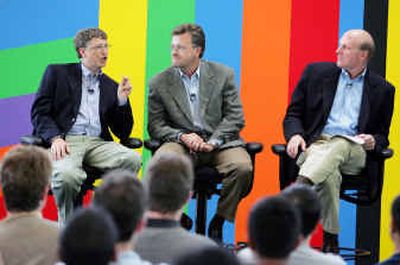The maturing of Microsoft

NEW YORK – Who is the average Microsoft Corp. investor? Is it one of the company’s many millionaire employees? A caffeine-and-adrenaline riddled day-trader? A major institution like Morgan Stanley or Goldman Sachs?
Or Donna Jones, a retired school administrator in Brookville, Ohio?
“I didn’t own Microsoft until, oh, I think it was this March,” Jones said Wednesday, a day after the software giant announced $75 billion worth of planned dividends and stock buybacks. “There was a big dip in the price and I thought, well, this is a good time to get it. Even then, the nice part of the stock for someone my age was the dividend.”
Microsoft … a dividend play? The software maker that not only redefined personal computing, but also helped incite the dot-com boom of the ‘90s, is now considered a safe bet for retirees?
“There’s no doubt that Microsoft used to be a large-cap growth stock, and there was an element of risk to that,” said Joe Keating, chief investment officer for AmSouth Bank’s asset management group in Birmingham, Ala. “But they’ve had to evolve, and they’ve done so. It’s more of a cash generator than a growth company.”
With Microsoft’s announcement Tuesday of a $3 special dividend, a doubling of its annual dividend to 32 cents per share and a $30 billion stock buyback program, investors large and small are in agreement – Microsoft may not be the high-flying growth stock it was during the 1990s, but it is part of a select group of stocks that are among the most widely held issues in the United States.
“It’s a major core holding, and it’s a rare portfolio or fund that doesn’t have a stake in it,” said Lincoln Anderson, chief investment officer at LPL Financial Services in Boston.
That’s a huge shift for a stock that has been publicly traded for just 18 years. An investor who bought $100 worth of Microsoft stock in 1986 would have more than $33,000 today, thanks to nine stock splits and a massive run-up in price in the late 1990s.
However, those who invested in Microsoft more recently would be disappointed. The stock has hovered around the $25 mark, split-adjusted, for the past three years. While the company’s earnings have been strong, the company hasn’t outstripped the rest of the market the way it did in the past. Performance like that led some investors, yearning for the returns of the past, to dump the stock.
“When I sold it around late 2000, it was clear to me that as a classic growth stock, it just wasn’t performing like one,” said Joe Craig, a physicist in Ellicott City, Md., who purchased Microsoft stock in the mid-1990s. “Now, every time I look at Microsoft, I think there are better growth stocks I could be buying.”
But for every investor who dumped it, it seemed two others picked it up, making Microsoft one of the most widely held stocks in mutual funds, 401(k) retirement plans and individual portfolios. According to the National Association of Investors Corp., Microsoft is the sixth-most widely held stock among U.S. investment clubs, with 7,889 clubs holding approximately 8.4 million shares.
For those doing the math, the $3 special dividend equals out to an average of $3,194.32 per club, and the quarterly dividend will mean another $340.72 annually for club members to reinvest. And don’t forget the lower tax rate on dividends on top of that.
For many investors, especially those who were old enough to first invest in Microsoft before the late 1990s boom, the shift from growth in stock price to growth in dividends comes at the perfect time.
“We’ve held Microsoft for at least the past 10 years or so,” said Mimi Rauschelbach, a retired entrepreneur in Phoenix. “Of course we got great returns for a while, and then we didn’t. We held onto it over the past three years because they were sitting on all that cash, and we knew they would have to do something with it. Being retired, the dividend is just wonderful.”
So move over General Electric, Pfizer and AIG – Microsoft is ready to join the ranks of the high dividend yield stocks, an older, more conservative crowd once ruthlessly mocked by the day-traders and dot-commers that were once Microsoft’s most numerous constituency.
“It’s like Microsoft has grown up,” Jones said. “They even seem friendlier these days.”